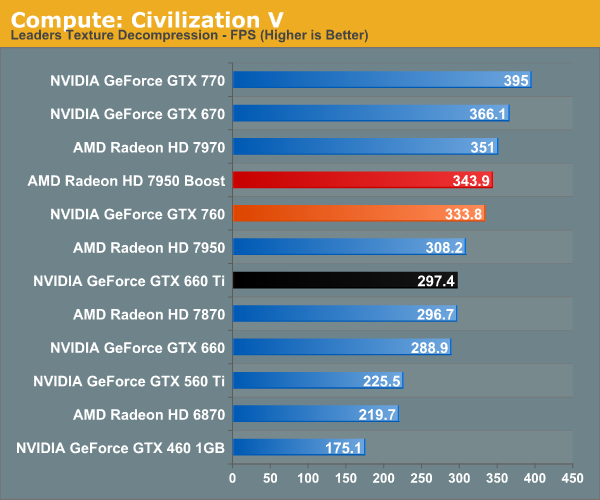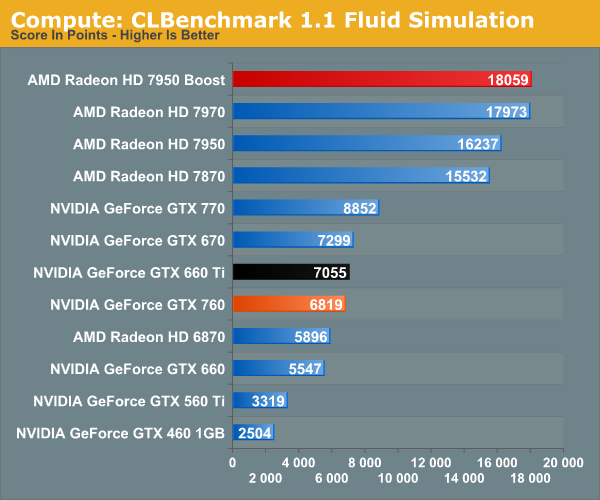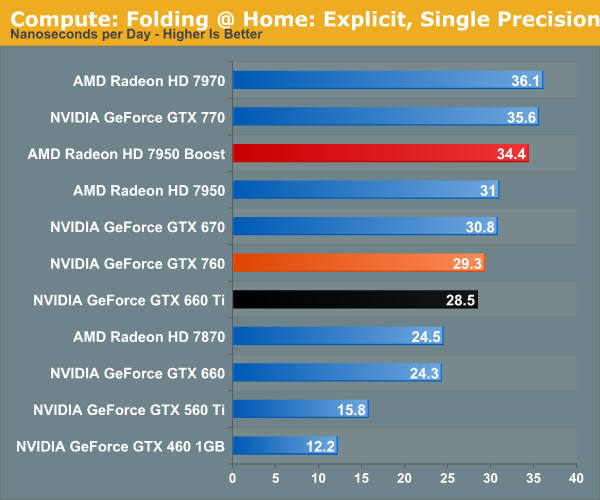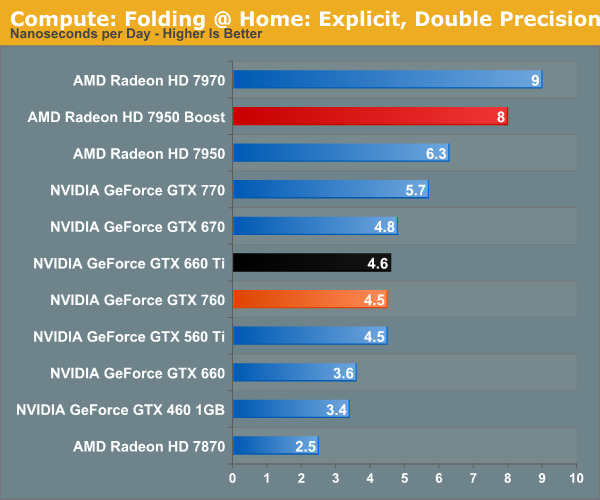NVIDIA GeForce GTX 760 Review: The New Enthusiast Kepler
by Ryan Smith on June 25, 2013 9:00 AM ESTCompute
Jumping into compute, we aren’t expecting too much here. Outside of DirectCompute GK104 is generally a poor compute GPU, and the loss of an SMX relative to the GTX 660 Ti isn’t doing the GTX 760 any favors here. By all appearances the GTX 760 is even more of a pure gaming card than the GTX 660 Ti was.
As always we'll start with our DirectCompute game example, Civilization V, which uses DirectCompute to decompress textures on the fly. Civ V includes a sub-benchmark that exclusively tests the speed of their texture decompression algorithm by repeatedly decompressing the textures required for one of the game’s leader scenes. While DirectCompute is used in many games, this is one of the only games with a benchmark that can isolate the use of DirectCompute and its resulting performance.

Civilization V once more validates that NVIDIA’s DirectCompute performance is generally up to snuff in this case. The fact that the GTX 760 is ahead of the GTX 660 Ti by any degree took us by surprise at first, but we’re likely looking at a scenario where the wider memory bus and/or larger L2 cache of GTX 760 offset some of the general compute gap.
Our next benchmark is LuxMark2.0, the official benchmark of SmallLuxGPU 2.0. SmallLuxGPU is an OpenCL accelerated ray tracer that is part of the larger LuxRender suite. Ray tracing has become a stronghold for GPUs in recent years as ray tracing maps well to GPU pipelines, allowing artists to render scenes much more quickly than with CPUs alone.

Luxmark is entirely about compute performance, and as a result this is an exceptionally poor showing for the GTX 760, with the GTX 660 Ti having no trouble besting it.
Our 3rd benchmark set comes from CLBenchmark 1.1. CLBenchmark contains a number of subtests; we’re focusing on the most practical of them, the computer vision test and the fluid simulation test. The former being a useful proxy for computer imaging tasks where systems are required to parse images and identify features (e.g. humans), while fluid simulations are common in professional graphics work and games alike.


Breaking down our CLBenchmark results, the computer vision test has frequently favored raw clockspeed over total shader throughput, which gives the GTX 760 an interesting advantage here. It’s capable of easily leaving the GTX 660 Ti in the dust and even edge out the GTX 670. Of course this is still less than 2/3rds the performance of even the slowest AMD GCN card, reflecting AMD’s superior computer performance.
The fluid simulation is especially brutal in that regard. Once again shifting back to an almost complete reliance on shader throughput, GTX 760 slightly trails GTX 660 Ti, never mind the nearly three-fold difference between it and the 7950B.
Moving on, our 4th compute benchmark is FAHBench, the official Folding @ Home benchmark. Folding @ Home is the popular Stanford-backed research and distributed computing initiative that has work distributed to millions of volunteer computers over the internet, each of which is responsible for a tiny slice of a protein folding simulation. FAHBench can test both single precision and double precision floating point performance, with single precision being the most useful metric for most consumer cards due to their low double precision performance. Each precision has two modes, explicit and implicit, the difference being whether water atoms are included in the simulation, which adds quite a bit of work and overhead. This is another OpenCL test, as Folding @ Home has moved exclusively to OpenCL this year with FAHCore 17.


Unlike some of our other compute benchmarks, the GTX 760 doesn’t fare too poorly here when it comes to single precision. However it’s still notably behind the 7950B in this case. And with double precision it’s no contest.
Wrapping things up, our final compute benchmark is an in-house project developed by our very own Dr. Ian Cutress. SystemCompute is our first C++ AMP benchmark, utilizing Microsoft’s simple C++ extensions to allow the easy use of GPU computing in C++ programs. SystemCompute in turn is a collection of benchmarks for several different fundamental compute algorithms, as described in this previous article, with the final score represented in points. DirectCompute is the compute backend for C++ AMP on Windows, so this forms our other DirectCompute test.

As another compute throughput bound benchmark, the GTX 760 is essentially tied with the GTX 660 Ti. This benchmark is somewhat memory bandwidth sensitive, which is why the GTX 760 doesn’t outright lose to the GTX 660 Ti here.










110 Comments
View All Comments
kennyG - Tuesday, June 25, 2013 - link
I for one was not happy with the out come of the 760 tested . I wanted Nvidia to totally take the 670 and enhance it and make a 760..Do the same process like they did with the 680 to 770. I really wanted to buy this card... Waiting for this one and I'm pisssed.Laststop311 - Tuesday, June 25, 2013 - link
I wonder how 2 of these(500) in sli compared to the GTX 780 single gpu (650)xTRICKYxx - Wednesday, June 26, 2013 - link
About Titan/GTX 690 levels.Ribozyme - Tuesday, June 25, 2013 - link
Ryan, could you please elaborate why the 760 draws considerably more power than a 670 while still being slower? Is this because a lower clocked 670 is compared to a pretty high clocked 760 in comparison? What would the situation be if you compared a 760 to a 670 clock per clock? And would I be able to power this with a be quiet straight power e9 400w + 3770k folding 24/7 ?And last question, are your power consumption values measured from the socket with a watt meter or with ampere meter on each cable and then added up?
Ryan Smith - Tuesday, June 25, 2013 - link
The biggest difference between the 760 and 670 is that the 760 has GPU Boost 2.0, which is a significantly different method of adjusting clockspeeds around temperature and power limits. The 670 had a TDP of 170W, but in practice its power target (a concept that doesn't exist with Boost 2.0) was below that. Whereas the GTX 760, if not constrained by temperatures, will get closer to its 170W TDP more frequently.The other difference is as you note: clockspeeds. The GTX 760 has fewer SMXes, but it operates at a higher clockspeed and with higher voltages (1.2v vs. 1.175v). That really eats up power at the highest boost bins. The 760 is essentially a little less wide and a little deeper than 670; clock for clock the 670 is going to be faster (but it won't be able to clock quite as high).
As for your PSU question, I'm afraid I can't answer that in any confidence. Based on specs I'd think that would work, but I don't know anything about that PSU.
Finally, power consumption is measured at the wall.
JimmiG - Wednesday, June 26, 2013 - link
Many non-reference GTX 670's boost higher, though. For example, my KFA² GTX 670 almost always boosts to 1,189 MHz, sometimes higher. If you can find a cheap, non-reference GTX 670 before they go out of stock, it might be a better deal.vision33r - Tuesday, June 25, 2013 - link
The last 3 years we saw really no innovation in the desktop GPU market. If you bought a HD 5870, you can still rock that card today in every game without any issue. We will see most of today's card get tossed when 4k monitors become a reality. Even SLI/CF top end cards today will score sub 30fps when games are played natively at 4k res.Kutark - Tuesday, June 25, 2013 - link
Ive been looking for the right price point to upgrade my GTX570, especially with BS4 coming out soon. I was hoping this would be it, but it looks like its really not enough of a jump to justify $250, especially when i could put that money towards a PS4 for some of the console games that wont be ported to PC. Any opinions otherwise?Kutark - Tuesday, June 25, 2013 - link
Haha, meant to say BF4, but yah, you get what i meant lol.mapesdhs - Tuesday, June 25, 2013 - link
:D That was a good one. :)
I suppose it depends on what you want from an upgrade. Are you looking for at
least a 2X speedup? If so then yes, atm you'd probably have to aim higher than
a 760. Indeed, I have a hunch that 570 SLI might match a 770 (that's an option I
suppose, get a 2nd used 570 for the interim).
Ian.